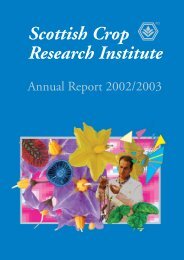SCRI Annual Report 2003/2004 - Scottish Crop Research Institute
SCRI Annual Report 2003/2004 - Scottish Crop Research Institute
SCRI Annual Report 2003/2004 - Scottish Crop Research Institute
Create successful ePaper yourself
Turn your PDF publications into a flip-book with our unique Google optimized e-Paper software.
Director’s <strong>Report</strong><br />
tion. Other sustainability issues are balancing inputs<br />
and outputs with improved knowledge of crop nutrient<br />
needs; the use of animal and green manures, composts,<br />
peat, sewage sludges, abattoir wastes, and lime;<br />
above-ground and below-ground region-specific biodiversity;<br />
the design and establishment of refugia and<br />
dispersal corridors (mainly wide headlands and wide<br />
and tall hedgerows) for native flora and fauna; curtailing<br />
agricultural emissions (greenhouse gases, pollutants,<br />
pharmaceuticals etc.); and improved water<br />
management (protected and semi-protected cropping,<br />
irrigation, hydroponics, avoidance of flooding and silt<br />
damage, avoidance of salinity problems etc.). More<br />
refined weather and market forecasts, and monitoring<br />
(often remote) of the weather, crop performance, and<br />
pest and disease incidence have given rise to effective<br />
decision-support systems as an essential modern farming<br />
tool. Inadequate attention has been given in<br />
recent times to crop rotation – the successive cultivation<br />
of different crops in a specified order on the same<br />
field. In central Africa, 36-year rotations have been<br />
reported with a crop of finger millet rotating with a<br />
35-year growth of woody shrubs and trees. In principle,<br />
similar systems prevail in the rest of the world<br />
where long-lasting perennial plantation crops (e.g.<br />
raspberries) are rotated with conventional annual or<br />
biennial arable crops. Short-term planning in the allocation<br />
of research funding has by-passed long-term<br />
studies using modern technologies on the impacts of<br />
specific crops and their rotations on soil fertility and<br />
soil structure.<br />
In concert with modern mathematics, chemistry,<br />
physics, computing and information technology, supply-chain<br />
management, food and industrial product<br />
processing, and satellites, transgenic technology with<br />
its hugely innovative potential to address hitherto<br />
intractable environmental, human and plant health,<br />
quality, and production efficiency issues, is but the latest<br />
scientific advance in the progress of global agriculture,<br />
horticulture, managed forestry, and the human<br />
condition. According to J.S. McLaren of StrathKirn<br />
Inc., the next phase of agriculture will be the age of the<br />
biorefiner, involving bioprospecting, biomimetics, biocatalysis,<br />
biomaterials, and the design and exploitation<br />
of organic compounds and products derived from<br />
them, and biologically derived energy. This view is<br />
supported by the recent investment decisions of many<br />
major corporations. Many rapidly developing LDCs<br />
such as India and China regard modern agriculture as<br />
the key to their future economic success, reform, and<br />
sustainability. 2002-<strong>2003</strong>.<br />
Types of Agriculture In the MDCs, organic, conventional,<br />
and ‘biotech’ (GMO-based) farming is practiced<br />
to varying degrees; in the LDCs, there also<br />
remains subsistence or peasant agriculture that confines<br />
its practitioners to grinding poverty and little dignity.<br />
Organic agriculture in the MDCs operates with<br />
a focus on soil fertility, ecological principles, crop rotation,<br />
and a belief in the rectitude, sustainability, and<br />
biodiversity-enhancing characteristics of its approach<br />
and the validity of its rules which preclude synthetic<br />
fertilisers, synthetic pesticides, and GM crops.<br />
Criticisms of the organic model include (a) its inability<br />
to validate claims as to the health-enhancing qualities<br />
of organic foods, (b) its low productivity compared<br />
with conventional and biotech agriculture, (c) dependence<br />
on the use of poisonous copper salts, (d) acceptance<br />
of blemished produce and the risk of mycotoxins<br />
and other antinutritionals as well as reduced vitamin C<br />
levels, (e) reliance on faecal fertilisation with consequential<br />
concerns about contamination of organic produce<br />
by food-poisoning micro-organisms and the eggs<br />
of parasitic nematodes as well as concerns about the<br />
pollution of water courses, (f) organic farms and holdings<br />
acting as repositories of pests and diseases, (g)<br />
reliance on tilling leading to damage of soil structure<br />
and the release of greenhouse gases, (h) marketing<br />
based on (or associated with) criticism of and sometimes<br />
scaremongering about conventional and biotech<br />
agriculture, (i) reluctance to adopt and suspicion of<br />
new scientific and technological advances, although<br />
modern breeding systems not involving transgenic<br />
organisms, and molecular diagnostics are accepted, (j)<br />
the inability of organic farming methods to meet<br />
increasing demands on global food supplies without<br />
encroachment on natural habitats, (k) the high cost of<br />
production compared with conventional and agbiotech<br />
systems, and (l) susceptibility of organic produce to<br />
competition from fraudulently labelled conventional<br />
produce.<br />
Conventional agriculture covers a wide spectrum from<br />
the unsustainable to the sustainable. The more<br />
advanced conventional systems have adopted new scientific,<br />
engineering, and technological approaches, and<br />
have shown long-term systematic productivity<br />
improvements. Conventional farming has met the<br />
nutritional needs and demands of a rapidly expanding<br />
global population. Criticisms of the conventional<br />
model include the following. (a) The reliance on<br />
tillage still prevails in most types of conventional agriculture<br />
and there is only a slow uptake of no-tillage or<br />
minimum-tillage systems. (b) Efficiency gains have led<br />
to politically embarrassing surpluses even if they have<br />
85
















